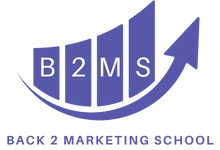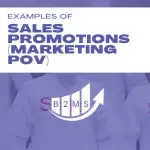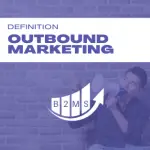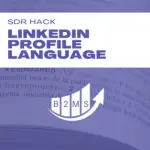Outbound & Inbound SDR Marketing done right
I’ve started my Marketing career as a Sales Development Representative (SDR). While I reported to Sales, I noticed that Sales Development needs to align more with Marketing than Sales in the lead generation strategy.
Later on, as I moved my ranks up in the Marketing department I was the Demand Generation Manager as well as Sales Development Manager in one person. I managed the SDR team as well as the company’s demand generation strategies and tactics.
In this post, I will show you why Sales Development Representatives are the perfect bridge between Sales and Marketing – regardless of what the Org Chart says. Because the title of SDR already includes “Sales”, I’ll refer to the role as SDR Marketing.

Sales and Marketing Alignment
SDR Marketing is the bridge between Marketing and Sales organizations. While SDRs may work closely with Account Executives on a daily basis, the strategy must align with Sales and Marketing. Some lead generation channels and tools are Sales tools and processes, while others are Marketing.
SDR Marketing Role
Let’s see the bigger picture of the tasks here. SDR roles are mainly divided into two strategies: handling inbound and sourcing outbound leads to ultimately close more deals and generate more revenue.
Inbound Leads
Lead generation and consequently Inbound lead handling is one of the most important tasks of Marketing. The role of the SDR is easy on paper: qualify the leads and hand qualified leads over to Sales. In reality, this is a complex process with Marketing Automation software, Account Lists, and missing information. Inbound SDRs are gold to the company because they add the human factor to the equation.
Inbound SDR Marketing can be further divided into two tactics: passive and active
Passive Inbound SDR Marketing
The process is very easily explained and works for every company at various stages. At some point, a generated lead appears in front of the Inbound Sales Development Representative. The goal of the Inbound SDR is to qualify the lead and decide the next step in the customer journey. For illustration, I use 4 paths but this could be an infinite number depending on your company:
- Lead disqualified: Lead does not fit the criteria at all and probably never will. This could be because they reached out to the wrong company or other parameters.
- Lead nurturing: The lead is not Sales ready yet but might be in the future. The goal should be to nurture the lead until they are Sales Qualified and ready to buy.
- Further information required: The lead can’t be qualified yet based on the provided information. Further information gathering needs to happen. This could be through a direct conversation with the lead via email or phone, or prior company engagement, but also internet research.
- Sales Qualified Lead: The lead checks all the boxes and should be handed over to the correct Sales Rep.
You see, there are already many factors that come into play from a Marketing perspective. In order to conduct the inbound lead qualification and decide the next steps for the lead, the high performing SDR needs to know further marketing campaigns:
- What are the demographic, geographic, or firmographic lead qualification criteria?
- What nurture streams are available?
- Understanding the lead gen marketing campaigns with all the assets may help to understand the lead further. For example, was it from a content distribution campaign or a specific PPC initiative with a dedicated landing page?
- What are previous campaigns the lead may have interacted with?
- How did the lead end up on my desk? Understanding the lead flow of inbound leads.
- How does the lead scoring work?
The list can go on.
Active Inbound SDR Marketing
While leads get routed to the SDR for passive inbound leads, the Sales Development Rep can also conduct active Inbound SDR Marketing by converting leads through the given MarTech tools.
For example, a live chat on the website can be utilized to convert website visitors to leads. The visitor may or may not have started a conversation with the chatbot. In either case, the Inbound SDR can take over the conversation and talk to the visitor.
Another example could be abundant form fills or returning website visitors. While the tactics needed might overlap with Outbound Sales Development, the message and timing are tied to the inbound activity.
Outbound Sales Development
Outbound Sales Development or Business Development is naturally closer to Sales because of reaching out to the right prospects, aligning with AEs, and there may never have been a marketing touchpoint prior to a cold email.
However, it’s still crucial to align between the Marketing and Sales teams. Here are 5 factors the Outbound SDR needs to align with Marketing.
- Account Based Marketing: ABM is one of the most aligned strategies. Sales Development Reps usually go after the lower priority lists to support Sales and Marketing alike. The very important (One-to-One or One-to-Few ABM) accounts are usually out of reach for SDRs. However, they still need to know and understand the list.
- Messaging: Outbound SDRs should use pre-approved messaging that works for Sales and Marketing.
- Events & Field Trips: Often, at least pre-COVID, B2B companies attend or sponsor industry conferences. The SDR team can help to set appointments to get the most out of these events. Additionally, AEs may do field trips and the SDR can help secure more meetings while the Account Executive is in the city.
- Technology: SDRs need to be aware of the technology and also understand how Marketing used it. It’s not uncommon that outbound SDR emails result in website traffic. For example, the prospect could engage with the chatbot then.
- Inbound SDR Marketing: The outbound SDR needs to understand the processes of the inbound SDR and vice versa.
Should SDRs be reporting to Marketing or Sales?
I want to be clear, I’m not saying that SDRs should be a Marketing or Sales role. In fact, it doesn’t matter as long as they report and align with both departments. In the end, closing the business is the goal for both sides.

Sascha is a Lifecycle Marketing Consultant with over 8 years of digital marketing experiences in Silicon Valley, the UK, and Germany.
After leading the demand generation for a 100+ million company, he decided to venture out on himself. He’s now helping clients to attract and convert more leads and customers.
His main focus are SEO, paid media & marketing automation – all with the focus to tie marketing campaigns to revenue.
Sascha has been featured in industry publications.




